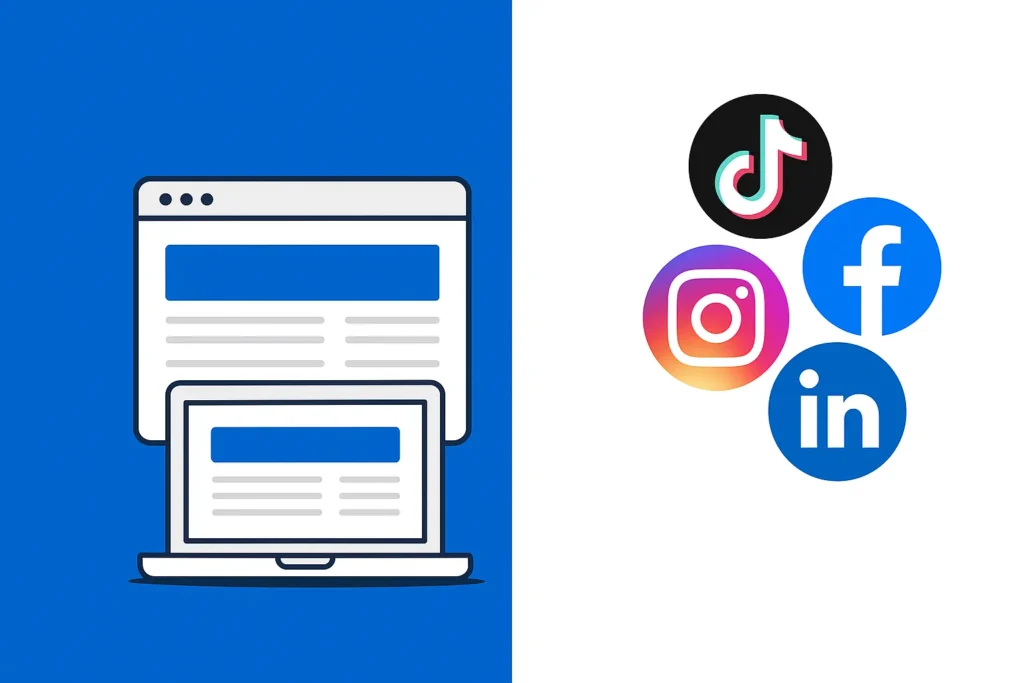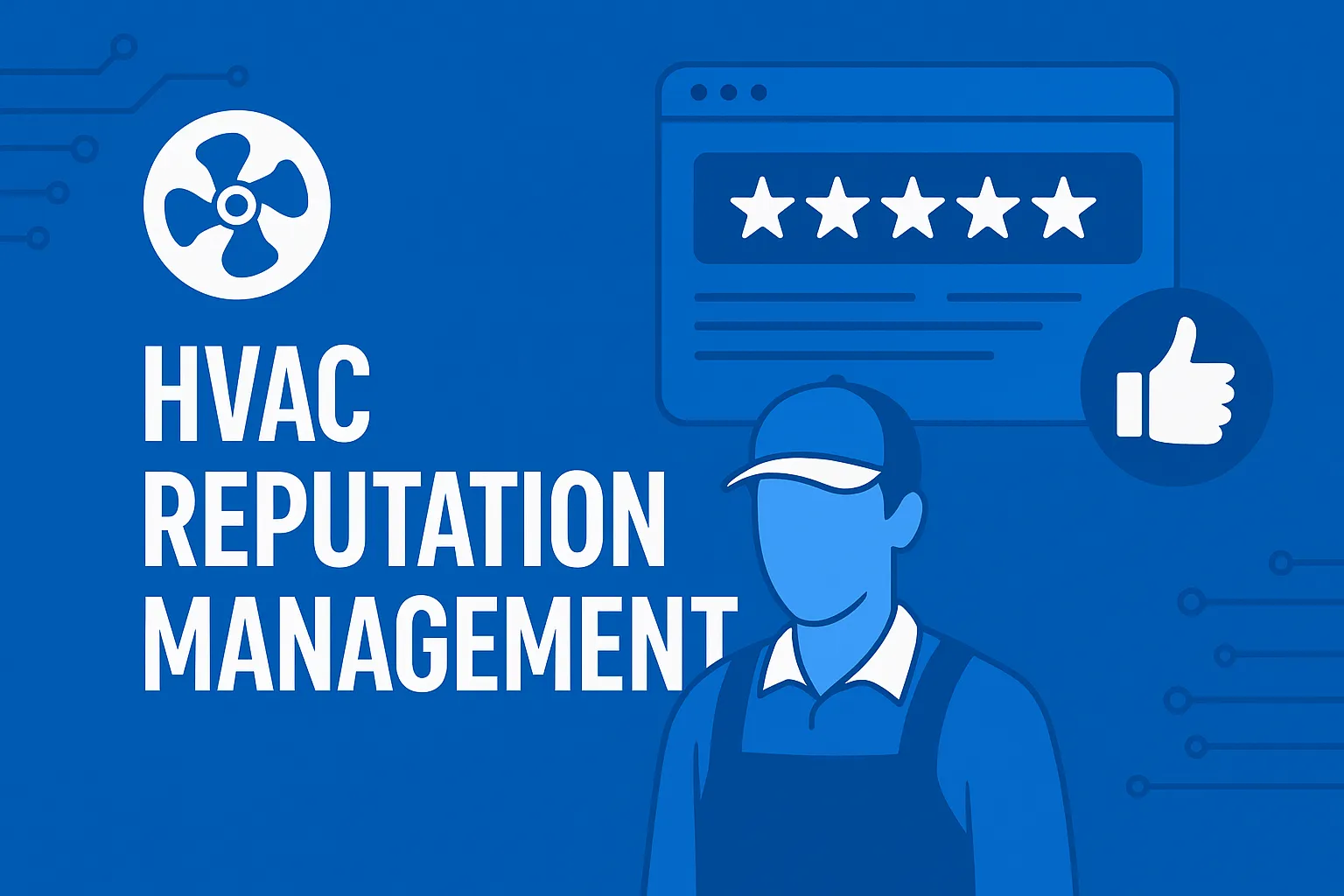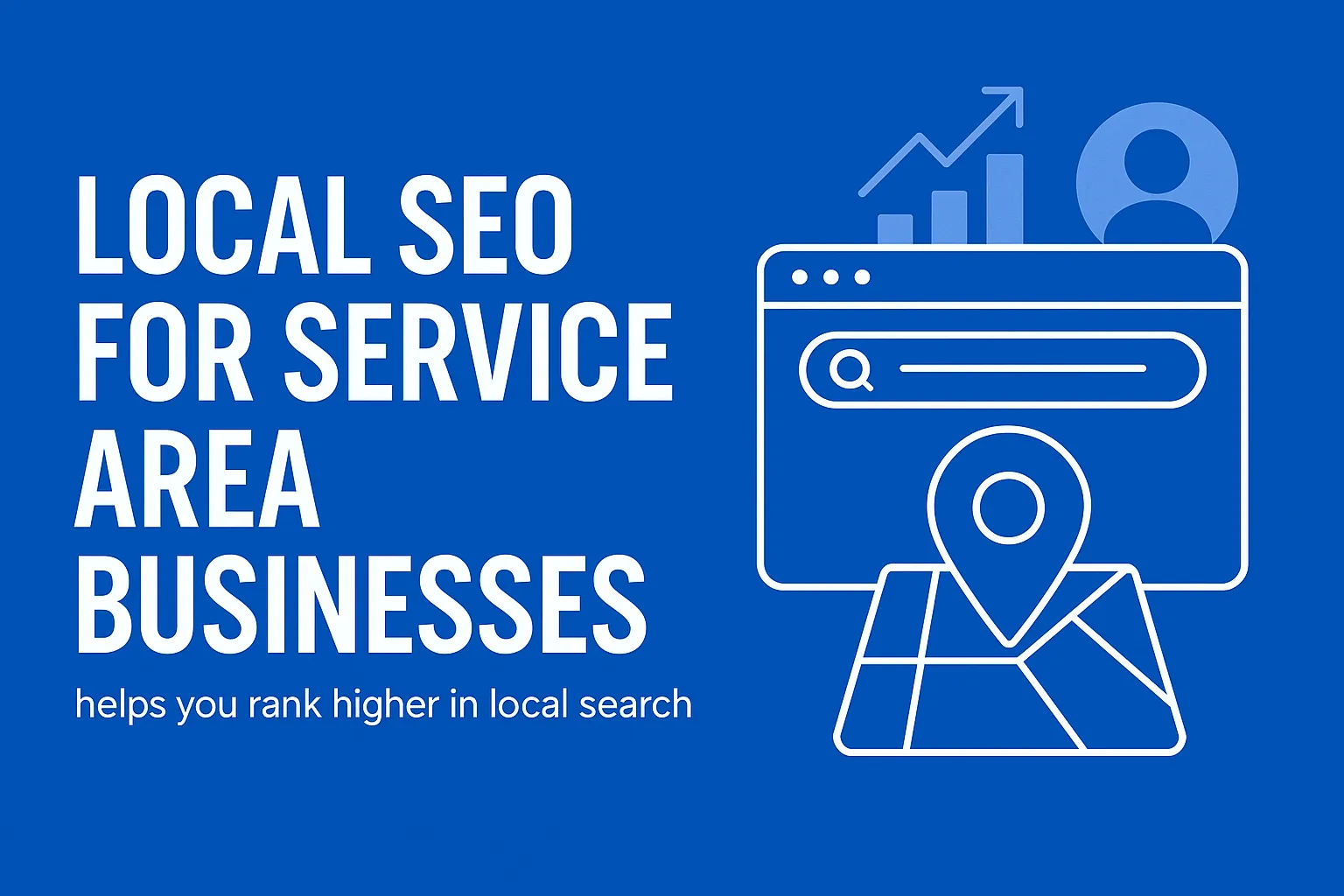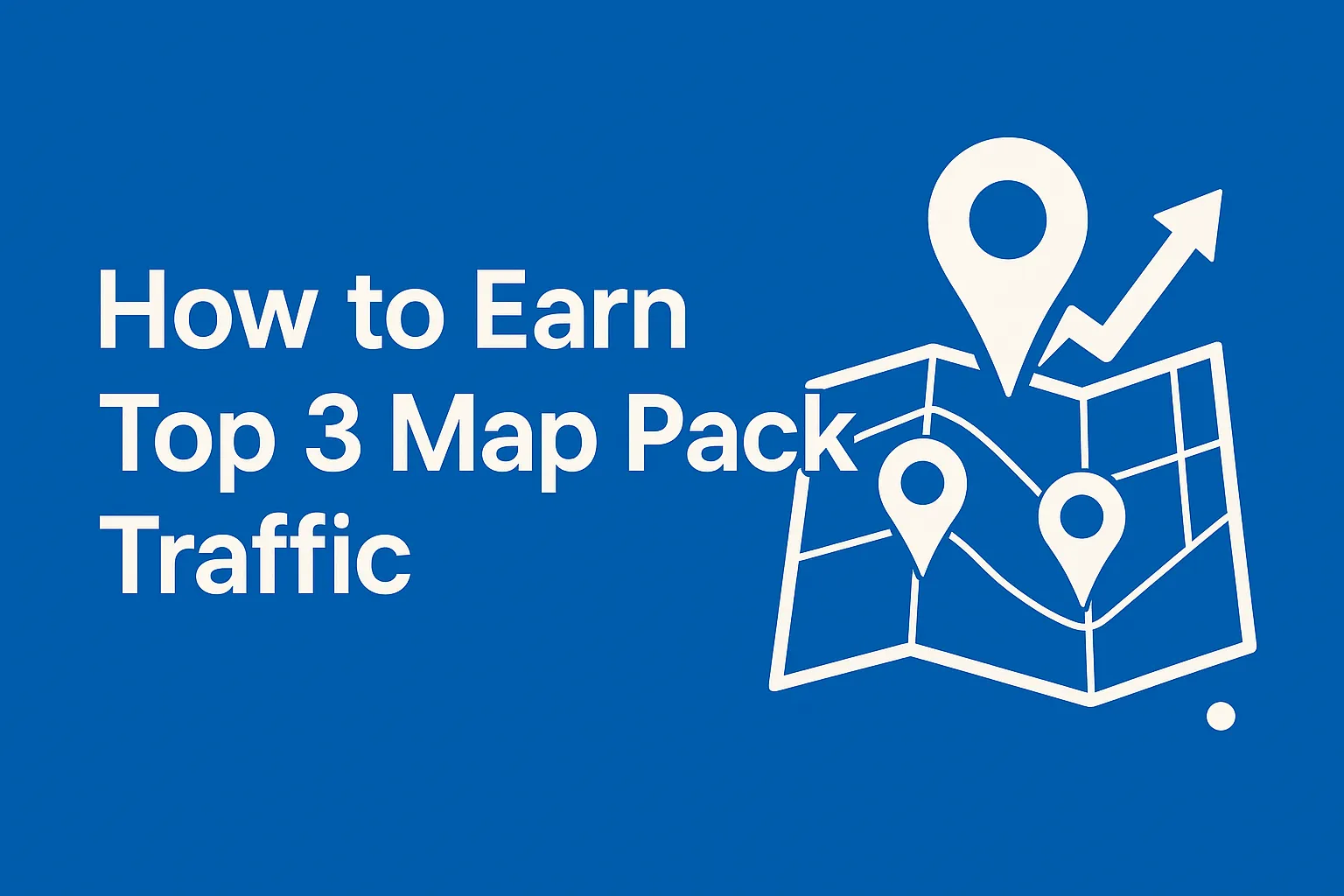Before You Go—Let’s Boost Your Leads!
Join our community of successful HVAC and Plumbing contractors who trust Klutch Growth to enhance their online presence.
Klutch Growth Blog
Website vs Social Media in 2025: Why a Website Still Matters
Website vs Social Media in 2025 is a question many small business owners, entrepreneurs, and growth marketers are asking as they look for ways to build visibility and create a customer channel that lasts beyond the next algorithm tweak. In reality, website and social media aren’t competitors. Used together, they’re your smartest play.
You’ve seen it happen. A 15 second TikTok post can make or break a brand overnight. That’s why so many execs wonder: “If social media already drives sales, do I still need a website?” The short answer is yes. Social platforms can bring users to you, but your website is the foundation you actually own.
Think about it this way. Your website is prime real estate you control. Social media platforms are rented billboards that can disappear overnight if the rules change.
Picture this. You’ve been posting regularly. Instagram looks polished, Facebook views are climbing, and your following is growing. Then one morning, you log in and your reach has dropped by 70 percent. No reason. No warning. Just gone.
That’s why in 2025 the question isn’t whether having a website matters. It does. The real question is whether you can afford to put your future in someone else’s hands.

What’s the real difference between a website and social media?
Understanding the core differences between websites and social media is the foundation of any smart digital strategy. Since these platforms serve distinct purposes, confusing them can seriously limit your business potential. One key thing to always have upfront, though, is that a website is not social media, in the same way that social media is not a website.
What Each Platform Is Meant to Do
- Website: Your page serves as your owned media hub, where you have complete control over design, content, and the customer journey. It’s your digital storefront built for detailed information, product showcases, and conversions.
- Social media: On the other hand, social media is rented attention space, ideal for discovery, real‑time engagement, and viral moments. Perfect for quick updates and audience connection, but not a substitute for a permanent business base.
Who Really Owns Your Content
- Website: All your blog posts, product pages, and lead‑gen forms sit on servers you choose. As said earlier, it is your owned-media hub, and you control every aspect of the page with tools like WordPress or Wix.
- Social media: While you create content yourself, host platforms can tweak policies, restrict your content (or ban you entirely), and claim partial rights to your posts. You’re essentially renting space on someone else’s digital property; therefore, it’s not truly yours.
How Long Your Content Lasts
- Website: Content permanence. A blog post from 2010 can still drive traffic in 2030, building long-term search value.
- Social media: On platforms like LinkedIn, Instagram, and Facebook, stories disappear in 24 hours. Not to mention the struggle to stay top of mind for your audience, considering your posts get buried by new trends within days.
Design Freedom and Branding Limitations
- Website: You gain total platform control, as well as creative license, in the design of your website (layouts, interactive elements, custom fonts, etc.).
- Social media: You fit your brand into existing templates and formats; customization is limited, unlike web-dev platforms like Squarespace, which offer limitless customization for branding.
Why Relying Only on Social Media Is Risky for Your Business
If you’ve ever wondered if social media can replace your website, it’s a gamble with serious downsides. Depending solely on social media might seem cost-effective and low effort, but the reality is that social platforms are designed to serve shareholders, not your business goals.
Here are reasons why a social-only strategy isn’t recommended:
- You don’t own the platform: Account suspensions, policy changes, or outright shutdowns can leave you stranded with no customer contact information, not to mention a potential blow to your business’s credibility when customer dependencies get stuck.
- Algorithm dependency: Today you’re viral; tomorrow your reach plummets if you don’t chase the latest “Reels-style” format. You chase algorithm changes like a hamster on a wheel, and still have unguaranteed visibility.
- Poor search visibility: Without a website, you miss out on SEO-driven organic traffic; audience visibility is limited to the social media platform you’re on (good luck being found via Google when someone searches for your services).
- Ads ≠ SEO: Boosted posts may provide a short-term boost, but they don’t establish the lasting search authority that a website offers.
There’s no sugar-coating it: social-only strategies are a house of cards. A solid website provides a foundation of trust signals, such as reviews, certifications, and context, that algorithms can’t compete with.
What a Website Does That Social Media Can’t
A website offers exclusive benefits that make it essential for any serious business in 2025:
Professional Credibility That Converts
A polished website design sends trust signals and screams credibility. Customers expect a clear “About,” “Services,” and “Contact” section; features social profiles simply don’t offer. One of the key benefits of having a website is that visitors take you seriously, especially when your domain is polished and your website design is intentional, something a social profile simply can’t match.
Search Visibility (SEO) That Compounds
Your website is the engine for organic traffic. Every blog post and landing page adds to your SEO arsenal (meta tags, schema, internal links). With proper on-page SEO plus social shares, you harness both organic discovery and social buzz. Websites for small businesses need this in particular, as organic traffic isn’t something you can afford to turn your nose up at.
Lead Generation That Actually Works
If you need a website for your business, lead generation is a non-negotiable requirement. Contact forms, email capture, booking tools, and gated downloads —all live on your website and plug directly into your CRM or email platform. Social media platforms severely limit these crucial conversion tools.
Google Ads Landing Pages
With a website, you can tailor landing pages for paid campaigns to maximize Quality Score, lower CPC (cost per customer), and improve conversions, something you can’t do when sending traffic to a social feed.
Analytics You Can Fully Control
With tools like Google Analytics and Search Console, you own every session, click path, and conversion metric, with no data sampling or hidden metrics imposed by a platform. This gives you insights to actually improve your business performance.
How Social Media Still Adds Value (When Used Right)
Social media isn’t the enemy; it’s a complementary tool when paired with a website for effective website and social media marketing. Smart tip: Social media is your brand’s personality, while your website is substance and strategy.
- Real-time interactions: You can build your customer relationship and engagement through comments, DMs, and chats. Not only can you stay top of mind, but you also receive instant feedback that benefits your brand.
- Discovery and brand awareness: Viral loops, trending hashtags, and influencer partnerships amplify brand reach through powerful audience targeting.
- Ad formats & features: Stories, reels, live videos, and paid ads on platforms like Instagram and Facebook offer dynamic storytelling opportunities.
- Limited long-term impact: Without a website to direct followers to, social media struggles to convert traction from engagements into lasting business growth.
How a Website and Social Media Work Best Together
The magic happens when you combine web and social media for maximum impact. But if you’re curious about how to combine your website with your social media, here are a few tips:
- Link social profiles on your website: Clear icons in the header/footer guide visitors to your active communities. Additionally, link your website to your social media bios to ensure transparency and maximize lead capture.
- Add social sharing buttons to blog posts: Include social sharing buttons in your blog posts that allow readers to amplify your content with a single click, thereby extending your reach organically.
- Run social ads that lead to your website: Use targeted ads as a funnel into conversion‑optimized pages where you control the experience. Use UTM parameters to track which posts are most effective in converting visitors.
- Embed Instagram feeds or video content: Fresh social content keeps your site feeling alive and current. Embed Instagram feeds or TikTok videos on your site for fresh content. Also, use structured data to highlight social content in search results.
- Maintain brand consistency: Maintain the same color palette, typography, and tone across both channels to build trust and recognition.
- Use social media for awareness and engagement: Social channels nurture the top of your funnel and drive traffic to your conversion hub. Used strategically, SEO and social media synergy drive warm prospects to your owned channels, priming them for deeper engagement on your website.
- Use website for lead capture and sales: Your website should be capable of handling forms, carts, and checkouts with full customization. This way, you can collect customer details for future engagement and sales.
Choosing Where to Start: Website First or Social First?
As a small business owner, what should you invest in first: a website or social media for small businesses?
If Budget Allows
Build a basic website on WordPress, Wix, or Shopify first to establish your digital presence. For small businesses, WordPress offers the best long-term flexibility, while Shopify excels for e-commerce. For email capture, use Mailchimp.
If Budget is Tight
Launch on social media but plan your website concurrently; outline the site structure, snag your domain, and reserve hosting. Don’t let budget constraints delay your owned media strategy.
Goal-Driven Investment
While there are arguments for both websites and social media for small businesses, business goals play a significant role in the decision-making process. If the company is focused on SEO and long‑term lead generation, the priority should be a website. Likewise, if you’re particularly interested in generating immediate buzz and community building, then the first focus should be on social media.
Can I Run a Business Without a Website? (Short Answer: You Can, but Should You?)
Yes, you can operate solely on social media, but you’ll trade off:
- Credibility: Customers trust businesses with websites that show trust signals more than social-only operations.
- Discoverability: You’re invisible outside of platform silos, missing everyone who uses search engines for services you offer
- Control: You’re renting space in an ecosystem you don’t own, vulnerable to platform policy changes.
In plain terms, social-only is like putting signage in front of a mall without a shop; people might stumble in, but it’s far harder to build lasting momentum and sustainable growth. Success is harder to sustain with social-only strategies.
How Much Does a Website Really Cost in 2025?
Understanding the actual cost of a website in 2025 goes beyond the initial build. It’s an investment with various factors influencing the final price tag, from the approach you take to the features you need. Let’s break down what you can expect to pay, and the time commitment involved.
DIY Platforms: The Budget-Friendly Start
For entrepreneurs and small businesses with limited budgets, “do-it-yourself” website builders like Wix, Squarespace, and even simpler WordPress themes offer a cost-effective entry point.
- Up-front cost: You can typically expect to pay anywhere from $150 to $500 for a basic annual plan. This often includes hosting and basic templates.
- Ongoing cost: These platforms usually charge an annual or monthly subscription, ranging from $100 to $300 per year, depending on the features and e-commerce capabilities you choose.
- Time investment: Although seemingly inexpensive, the cost often comes in the form of your time. Building a functional and visually appealing website yourself can take anywhere from 1 to 2 weeks of dedicated effort, especially if you’re new to web design. You’ll be responsible for content creation, image sourcing, and learning the platform’s interface.
Custom Agency Builds & Webflow
For established businesses, those with complex needs, or brands seeking a truly unique online presence, a custom-designed website built by a web development agency or on platforms like Webflow offers unparalleled flexibility and performance.
- Up-front cost: These are significant investments, with initial build costs ranging from $2,000 to $10,000 or even more, depending on complexity, integrations, and branding requirements. This covers custom design, advanced functionality, and thorough testing.
- Ongoing cost: Beyond hosting (which may be higher due to dedicated server requirements), maintenance contracts for custom sites can range from $1,000 to $5,000 per year, ensuring security, performance, and regular updates.
- Time investment: A custom project requires a substantial time commitment from both sides. Expect the development process to span anywhere from 1 to 3 months, involving multiple rounds of design, development, and content integration.
Hidden Costs to Factor In (Regardless of Your Choice)
While the above covers the core web development, hosting, and maintenance fees, always budget for these often-overlooked expenses:
- Domain name: Your annual domain registration is a small but necessary expense, typically ranging from $10 to $20 per year.
- Premium plugins and software: Many advanced features (e-commerce add-ons, SEO tools, analytics dashboards) come with recurring subscription fees.
- Security (SSL Certificates): While some hosts include free SSL certificates, others may charge for premium certificates. This is crucial for securing your site and building trust.
- Content creation: High-quality text, images, and videos are essential. If you’re not creating them yourself, budget for copywriters, photographers, or videographers to handle the content creation. This is a crucial aspect of your content marketing strategy and has a significant impact on SEO.
- Marketing & SEO: Getting traffic to your site isn’t free. Factor in costs for ongoing SEO efforts, paid advertising, and social media management.
- Maintenance and updates: Websites require regular maintenance and updates. This includes software updates, security patches, backups, and fixing broken links or features. Neglecting maintenance can lead to costly issues down the line.
Starter Packages vs. Full Custom Solutions: What’s Right for You?
Starter packages or template-based solutions (e.g., a basic Wix site or a themed WordPress installation) are ideal for small businesses seeking a quick, cost-effective online presence with standard features. They get you online fast.
Full custom solutions (such as a bespoke agency build or an advanced Webflow site) are ideal for businesses with unique branding needs, complex functionalities, extensive product catalogs, or those heavily reliant on specific integrations. They offer ultimate control and scalability.
Ultimately, your website is an investment in your business’s future. The cost isn’t just a number; it reflects the time, effort, and expertise required to build a valuable digital asset.
Your Website Is a Long-Term Asset — Social Is Just a Tool
With an active website, you stand to gain;
- Equity over time: Every backlink, blog post, and product page adds cumulative SEO value that compounds monthly.
- Social is unpredictable: Social media channels are subject to policies out of your control.
- 24/7 availability: Your site never sleeps; social algorithms take breaks and limit your reach unpredictably.
- Social as messenger: Your website is the hub (your owned media), and social media is the spoke (distribution channels). Use social channels to deliver people to the hub; you own that home base permanently.
Treat your website as the headquarters, and social media as your fleet of couriers delivering messages far and wide.
Frequently Asked Questions (FAQs)
How often should I update my website compared to my social media?
For effective digital marketing, your website and social media channels need different rhythms. Your website, as your core digital asset, benefits from consistent, high-quality content updates, such as blog posts or service pages (aim for monthly), to boost SEO and demonstrate activity. Social media, vital for content distribution, demands more frequent, often daily, engagement (3-5 posts per week plus stories/reels) to maintain audience interest and algorithm visibility.
Can I connect my online store on social media to my main website?
Yes, connecting your online store is crucial for effective website and social media marketing. You can seamlessly integrate your website with social media platforms like Facebook and Instagram using tools such as Shopify and Meta Business Suite to sync your product catalog. This allows customers to discover products on social media and then complete their purchases directly on your website, giving you full control over the checkout process and valuable customer data.
What makes a good website for someone who doesn’t want to use social media?
Even if you don’t have a social media presence, a strong website can still build significant customer trust. A good website design in this scenario prioritizes straightforward navigation, strong SEO, detailed “About Us” and “Services” pages, prominent testimonials, and direct contact options, such as forms or live chat. Effective web development ensures the site is highly informative and user-friendly, compensating for the lack of real-time social interaction by being exceptionally comprehensive and conversion-focused.
Conclusion: Build Your Website. Use Social Media to Support It.
Here’s the bottom line: your website is your long-term asset and digital headquarters. Your social media channel is an amplifier, excellent at creating awareness and driving users to the top of your acquisition channel. Still, it is not meant to substitute for the work of a website (lead capture and conversion). In 2025 and beyond, invest in both, but always keep your foundation solid with owned media you control entirely.
Ready to take control of your digital presence and level up your strategy? Book a free website consultation today. Let’s transform your digital strategy into a sustainable growth engine that remains effective, regardless of the next algorithm update.
Need help with SEO, Google Ads, or design? Let’s talk. The best time to start was yesterday. The next best time is now.
Recent Posts
November 14, 2025
November 14, 2025
November 10, 2025
November 3, 2025




